Street skateboarding
Street skateboarding is a skateboarding discipline which focuses on flatground tricks, grinds, slides and aerials within urban environments and public spaces. Street skateboarders meet, skate and hang out, in and around urban areas referred to as "spots", which are commonly streets, plazas or industrial areas. To add variety and complexity to street skateboarding; obstacles such as handrails, stairs, walls, flower beds, bins, park benches, picnic tables and other street furniture[1] may be traversed as part of a single trick or a series of consecutive tricks called a line.
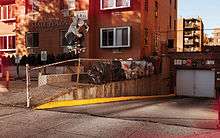
Clever and artistic uses of video and printed media have propelled street skateboarding to become the most widely accepted and participated form of skateboarding in the modern world.
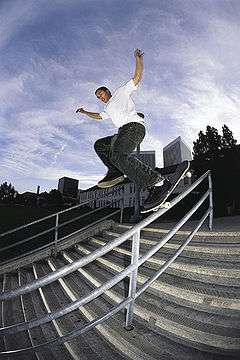
History
At the tail end of the 1980s and around the beginning of the 90s street skateboarding evolved as a new approach to Skateboarding from elements taken from the other existing Skateboarding disciplines.[2] Instead of drained swimming pools and riding purpose-built skateparks, Skateboarders began to utilise urban areas and public spaces. For example, in the 1980s, Philadelphia's LOVE Park transformed from a place where business people would eat their lunch, into a well known place to expect to see skateboarders practising tricks and engaging in skate culture.[3] A new style of skateboard deck (which had a kicktail at each end) became popular. Professional skateboarding became hyper commercialised and skate shops specialising in the retail of professional grade skateboarding equipment appeared in many cities across the world. Skate shops in turn helped support a culture of street skateboarding by offering skateboarders a refuge where they could check out and buy copies of the latest Skate Videos (VHS video tapes and then later DVDs), one of the few popular monthly magazine publications or other skateboard products.
The movement through urban areas evolved to where Skateboarders began riding within them exclusively; improving their skills by skating improvised courses made entirely of existing urban features.[4] As a result; Skateboarders who skate street observe architecture and look for indicators as to where skate-able obstacles may be found. This process occurs as part of a natural pursuit within a Metropolis to find new and interesting places and obstacles to skate.
According to Ben Kelly of Transworld Skateboarding Magazine; the ten best cities in the World to skateboard are: Barcelona,[5] Los Angeles,[6] New York,[7] San Francisco,[8] Paris,[9] Melbourne,[10] London,[11] Shenzhen,[12] Berlin[13] and Tel Aviv[14]
Tricks
Examples of tricks
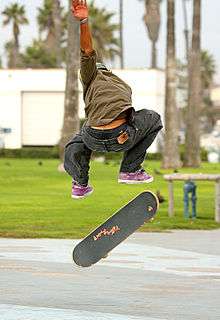 Hard-Flip
Hard-Flip- Five-O
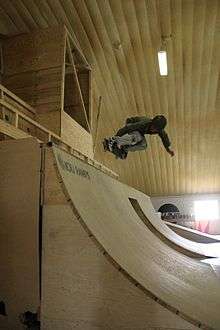 Backside Air
Backside Air Board-Slide
Board-Slide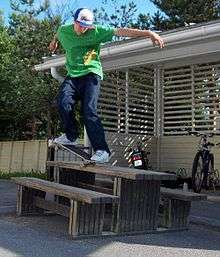 Nose Grind
Nose Grind Fifty-Fifty
Fifty-Fifty Crooked Grind
Crooked Grind Smith
Smith Lip-Slide
Lip-Slide.jpg)
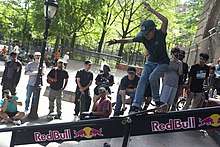 Feeble
Feeble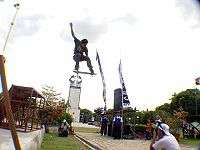
In street skateboarding, tricks can be attempted whilst standing either positioned normally, fakie, switch or nollie on a skateboard. And also whilst travelling either frontside or backside. Almost all of the tricks in street skateboarding require some amount of pop from either of the kick tails on the board to elevate the skateboard into the air; to start the attempt at the trick. Skateboarding has unique terminology which is used by skaters to describe ride, along with some very unique and important trick names.
With practice, tricks such as many grinds and slides can be optionally combined with other aerial type tricks such as the kick-flip to create variations. This applies both into and out of tricks and creates some interesting combinations. Doing so increases the difficulty level. Trick variation forms part of the journey onto a path of progression which a skateboarder may choose whilst they are learning new tricks. For instance; a 180 aerial rotation into a nose grind, followed by a kick-flip out is called a "180 nose grind flip out."
Tricks can be judged in various ways. Common signs of skill include how cleanly the trick was completed, the height of the obstacle involved, how fast the rider was travelling, the length of travel whilst grinding or sliding and the technical complexities involved in landing the trick. In street skateboarding, style is an important signifier of skill and individuality. For instance, professional skateboarder Tom Penny is renowned not just for his skill and ability on a skateboard but also for his smooth and relaxed style whilst skating and landing tricks.
The gateway to learning the most basic tricks involved in street skateboarding are grounded around the Ollie. Learning to Ollie and then moving onto other fundamentals such as the one eighty, pop shuv-it and the kick-flip creates the foundation for moving onto learn slides, grinds and variations. Discussing technique, studying video footage and also watching other skaters and how they skate are important points of reference for any skateboarder when learning tricks.[15]
Many advanced skateboarding tricks are extremely hard to pull off consistently and in some instances, risk serious injury in the event of accidental misstep. Learning many tricks can take a number of years of careful practice and to pull certain tricks off successfully will even then still require significant skill and concentration to execute properly.
Equipment
Street skateboards are built using individual professional grade component parts which are sold by specialist skateboard retailers. A part of the revolution of Street Skateboarding was the transition of the skate industry into the hands of skateboarders, who would design, manufacture and retail the products themselves. This removed the skate industry from the hands of venture capitalists who had created a monopoly in the 1980s. The industry has since gone full circle, with many grass root companies founded in the 1990s now sold to venture capitalist groups and enterprises. However, there are still a number of Skateboarder owned companies manufacturing skateboard products today.
Skate shoes
Appropriate footwear is an important item of street skateboarding equipment. Modern professional grade skate shoes evolved in part due to the increase in durability required as a result of the abrasion which constant practice causes to the material the shoe is made from. Innovations such as footwear technology[16] which attempts to reduce the risk of heel bruises, increase "board feel" and improve long term overall durability have improved not only skate shoes as a whole but also modern footwear in general.
Examples of skate shoes
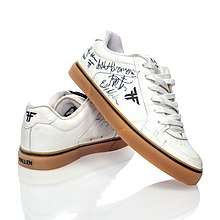 A pair of signed Fallen skate shoes.
A pair of signed Fallen skate shoes.- A pair of Osiris D3 2001 shoes.
 A pair of DC Court Graffik shoes.
A pair of DC Court Graffik shoes.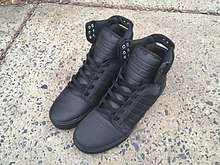 Supra Skytop Red Carpet shoes.
Supra Skytop Red Carpet shoes..jpg) A pair of Nike SB Blazer skate shoes.
A pair of Nike SB Blazer skate shoes.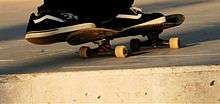 A pair of Vans skate shoes.
A pair of Vans skate shoes.
Prominent professional skateboarders design and endorse professional skateboard shoes, often with their name or logo featuring as part of the design of their signature "pro" model.
Since the 1990s, some of the most prolific pro skateboard shoe designers include Eric Koston,[17][18] Daewon Song,[19] Kareem Campbell,[20][21] Chad Muska,[22] Andrew Reynolds,[23] Marc Johnson,[24] Geoff Rowley[25] and Anthony Van Engelen.[26] With each of them having several iconic "pro model" designs mass-produced and sold as part of endorsement contracts with various professional skate shoe manufacturers.
Wax
Street skateboarders often travel with a block of wax which is rubbed onto masonry to prepare it before a trick is attempted. The wax helps reduce the friction between the surfaces of the two materials when tricks which involve grinding or sliding are attempted.
Complete skateboards
The design, manufacturing and evolution which has occurred in the production of modern professional grade skateboards has resulted in the standardisation around the use of Imperial measurement for decks, trucks, nuts and bolts. But wheel diameter is measured in millimetres.
Skateboard parts can be individually replaced and fixed should they require maintenance.[27][28] Skateboards can be serviced using a standard Imperial sized socket set, an off the shelf hex Allen key set and a small Imperial socket or spanner set. Traditional skate shops occasionally stock an all in one tool which has all of the required tools attached. Such tools are essential for travelling professional skateboarders and are useful to skaters who do not have easy access to all the required tools.
Specifications
The most common specifications of a modern professional grade skateboard suitable for street competition and practice are as follows:
- A single set of 4 wheels, 52mm wide and 99A in durometer
- A pair of low in height 7.6" wide trucks
- A 8" wide professional grade 7 ply Canadian maple deck
- 8 bearings
- 8 nuts and bolts
- A sheet of Griptape
There is no specific standard which should be followed when constructing a skateboard from parts. The consensus is that the board should just "feel right" once assembled after a few rides. Fully built setups are available to buy at Skate Shops and often provide excellent value for riders new to skateboarding.
Components
The technical specifications of specific component parts of a skateboard designed for street skateboarding vary from rider to rider and depend upon the following factors:
- Rider height
- Rider weight
- Shoe size
- Skill level
- Comfort
- Budget
- Preferred terrain, obstacles and style of skating
For example: A rider is small in stature and foot size, so therefore selects a deck which is 7 1/2 inches wide and a set of trucks which match the width of the deck. Another rider wants to skate street and ride parks, so selects an 8" wide deck, mid seated trucks of the same width and wheels of 54mm in diameter. Riders new to Street Skateboarding benefit greatly by seeking out advice regarding equipment from local skate parks and shops.[29][30]
Grip
Grip tape, cut to length from a roll at retail is traditionally black in colour and is a rubber sheet with an abrasive surface on one side and a covered bonded side (like a sticker) on the other. Grip tape is installed by peeling the backing off the rubber strip and carefully placing the entire sheet onto the top of a skateboard deck. The operation requires skill and can be tricky to perform, as it can be difficult to prevent the capture of air bubbles between the adhesive side of the sheet and the top of the skateboard deck. Once the sheet is in position, the edges of the sheet are filed away using a hand file until the rubber is exposed so that the sheet can be cut to fit using a sharp blade to remove the excess. Once applied, grip tape is extremely difficult to remove.[31]
Grip tape comes in various colours and can also be adorned with a decal. Often a place of customisation by the rider, a skateboarder may choose to cut out sections or shapes to decorate the top of the skateboard in expressive form or simply to enable them to distinguish the nose and tail end of their skateboard deck whilst they ride.
Decks
Board shapes have changed considerably since the 1970s but modern pro models have remained similar in shape since the invention of the deep concave double kicktail deck. The contemporary shape of the skateboard is derived from the freestyle boards of the 1980s with a largely symmetrical shape with a relatively narrow width.[32][33][34]
Decks can be as narrow in width as 7.5" or as wide as 8.75". And can come in sizes of 760 to 830 millimetres (30 to 33 in) in length.
Mass-produced Professional grade skateboard decks are traditionally glued multi-laminated, resin covered, seven ply pressed maple sandwiches cut and sanded to shape. The maple material traditionally comes from Canada and is usually described as "Hard rock Canadian Maple."
Graphics and decals are a very important personal preference when choosing a skateboard deck. Often skateboards are covered in graphics which make them prominent works of art and as such; pristine condition examples can become highly sought after collectors items, especially if the graphic is of cultural significance and/or was created by a prominent internationally known professional Artist.[35]
Stickers, often come mixed in with the packaging of brand new skateboard decks and can be optionally applied to the deck or just about anywhere. Stickers are an important promotional tool in the skate industry and are often given out for free at competitions or events.
With the skateboard facing forwards, a skateboarder who rides regular stance calls the kick tail of a skateboard closest to their back foot the "tail". The kick tail at the opposite end of the deck is called the "nose".
Trucks
Trucks are the axle part of the under carriage of a skateboard. Each truck is bolted to the underside of the skateboard deck using a set of four nuts and bolts. Rubber wheels containing bearings are positioned at each end of a truck component's axle and are secured using large threaded nuts at each end of the threaded axle rod. The manoeuvrability of the axle can be adjusted by adding or removing tension via a large central nut and bolt called the "kingpin." Adjusting the kingpin has the effect of either increasing or decreasing the turning circle of the skateboard. Onto the kingpin are positioned two rubber bushings used for compact movement and shock absorption, by sandwiching one above the axel and the other above the base plate. The two bushings are clamped to the kingpin via two flat round washers to retain them into position.
Professional grade trucks are commonly constructed using forged aluminium or magnesium around an iron or steel axel rod. Trucks come in various widths and heights to match deck width and riding style. Rider preference for truck height selection is commonly low for street, mid for mixed park/street and high for vert. Truck widths do not commonly exceed deck width, as to avoid injury from protruding axle rods whilst the skateboard is spinning during tricks.
Wheels
Skateboard wheels come in sizes between 48 mm and 62 mm in diameter and are made of polyurethane, with a hardness (durometer) anywhere above 80A. Some wheels will be made harder than measurable on the "A" scale and will have durometers of up to 84B (about 104A.) Skaters must make a compromise when choosing their wheels. A larger diameter offers lower rolling resistance and more speed but a smaller sized diameter makes some flip tricks easier to attempt. A softer durometer allows wheels to travel over cracks, bumps and rough pavements more easily, while a harder durometer offers less resistance during power slides, grinds, and other rail and ledge tricks.
In the early nineties as many flip tricks were being performed for the first time, smaller, harder wheels were preferred because they offered a slight competitive edge for very technical tricks. Skateboarders would often ride 48mm or sometimes even smaller sized wheels during this time. As skaters started performing tricks off of larger obstacles, speed became a more important factor. And as a result skaters began gravitating towards larger wheel sizes. Today; 52mm wheels are considered the standard size. Although, skateboarders may choose smaller or larger sized wheels depending upon if their style makes them more technical or aggressive, or when the terrain they are skating demands it.[36]
Bearings
Skate bearings come in one size. They are push fit and can be serviced and installed into rubber skateboard wheels by hand or using a tool. Usually consisting of a steel casing and steel or ceramic ball bearings, skate bearings are rated by ABEC, may come with a waterproof race guard and are lubricated commonly using grease.
Competitions
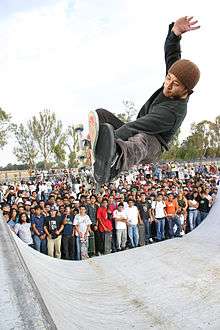

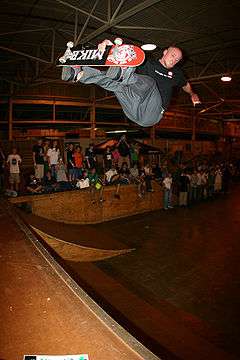
Skateparks
Competition level street skateboarding events are held within purpose-built skatepark arenas or cordoned off urban areas. Within a street skateboarding competition obstacle course; concrete, plastic, metal or wooden reproductions of obstacles naturally found within the urban environment are placed within adequate distance of each other utilising a natural style of positioning within the course.[37] A course is usually complemented by adding transitions which permit greater travelling speed and an increased amount of "air". Other forms of ramp such as funboxes which are designed with optimal space utilisation in mind are commonly found within a park's layout.
A popular street skateboarding spot, the West LA Courthouse building was converted into a skatepark after the courthouse shut down in 2012
The world's first ever purpose-built street skateboarding plaza was The Buszy in Central Milton Keynes, England.[38]
New York City is home to a number of skateparks.
The most famous indoor street style skate park in the world is The Berrics.
Examples of skateparks
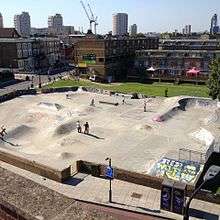
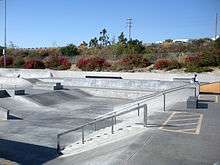
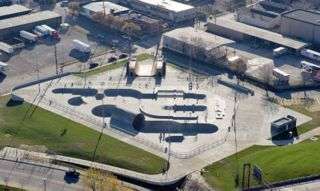
- A park in Mińsk Mazowiecki

.jpg)
Modern Street Skateboarding competitions employ a format where each participant has two timed attempts or "runs" to attack the course and "shred" (perform a series of tricks as cleanly as possible.) The entrants attempts are then scored by a panel of judges to decide an overall winner. Competition entrants who perform exceptionally well are traditionally vocally congratulated and encouraged by the crowd during and at the end of their run. Spectating Skateboarders commonly show their appreciation for well performed tricks or smooth runs by slapping their skateboard on a hard surface or obstacle in a complimentary, often respectful but mostly audibly enthusiastic way.
Notable competitions
A number of major international competitions include a street skateboarding event or component. Some examples:
Olympic Skateboarding
In March 2019, The United States announced members of their 2019 USA Skateboarding National Team.
The plan to run a Skateboarding event at the 2020 Summer Olympics[43] in Japan has caused controversy within skateboarding.[44] Concerns have been made about the sanctioning of skateboarding at the Olympic Games by World Skate, who have historically been an organisation concerned with roller booting activities. World Skate have not historically ever been involved with skateboarding prior to its inclusion into the Olympic Games and (as of September 2019) don't even have a valid SSL certificate for their own web domain.[45]
In May 2019, the scheduled skateboarding event was axed from the Lima 2019 Pan American Games. Panam Sports announced that skateboarding was removed from the sports program because World Skate could not guarantee that the best possible athletes would be in attendance. World Skate had scheduled a World Tour event which had an overlapping time frame with the Pan American Games and would also not authorize the competition as an Olympic qualifier.
A skateboarding event has been provisionally approved by the IOC for inclusion at the 2024 Olympic Games in Paris.[46] Skateboarding events will also feature at the 2022 Asian Games in Hangzhou.
Game of SKATE
The game of SKATE is a form of competition which requires no street obstacles and simply a perfectly smooth and sufficiently large skating surface for skateboarders to use to take it in turns to attempt to land flat land tricks.
Public perception
There are instances where local authorities in popular skateboarding areas have introduced initiatives which ban skateboarding, confiscate skateboards, or make skateboarding difficult or impossible via hostile architecture or by adding anti-skate devices to the environment.[47] These deterrents are commonly targeted at BMX riders, Rollerbladers and scooter Riders also and not just Skateboarders.
Examples of skate deterrents
 A sign prohibiting skateboarding
A sign prohibiting skateboarding A ledge peppered with skatestoppers
A ledge peppered with skatestoppers- Small sized skatestoppers
.jpg) Bolts are deployed in some areas.
Bolts are deployed in some areas. Spikes offer the risk of serious injury.
Spikes offer the risk of serious injury.
Local authorities often react to street skateboarding in public places as if it is a public nuisance. To deal with what authorities deem a problem, a local council or other authority meeting is often called. Such a meeting allows skateboarders to make their voices heard in the event of a proposal to introduce anti-skateboarding legislation. The outcome of this type of meeting is often the formation of some sort of local skateboarding group or organisation along with a drive to fund and build[48] a skate park.
Success stories
In 2002, for the skateboarders of Love Park in Philadelphia, city officials decided to deconstruct the park to deter skateboarders from using what officials considered "an area meant for productive citizens that gave back to the community."[49] By using the cover of the city's homeless problem, officials moved in and took steps to prevent skateboarding at the park and put an end to the bohemian lifestyle which had existed there. Years later, due to the tireless work of passionate skateboarders such as Josh Nims[50] and others; a spiritual replacement for Love Park was built named Paine's Park.[51] Located very close to the centre of the city, Paine's Park[52] attempts to recreate some of the unique obstacles and features of Love Park within a specially designated skateboarding environment. The undertaking involved quite some effort by a large number of very passionate and hard working people.[53] The result is a skate park the envy of the world over.
Local authority funded skate parks consistently prove to be important ventures for communities and can bring together local people in new and exciting ways in an effort to achieve a mutually beneficial common goal.
References
- Foster, Philip (29 April 2012). "Different Kinds of Skateboarding". LiveStrong. Retrieved 6 April 2013.
- The Man Who Souled the World at IMDB
- Howell, Ocean (November 2005). "The "Creative Class" and the Gentrifying City". Journal of Architectural Education. 59 (2): 32–42. doi:10.1111/j.1531-314x.2005.00014.x. ISSN 1046-4883.
- Goodfellow, Evan; Werner, Doug (1 June 2005). Street Skateboarding: Endless Grinds and Slides. Tracks Publishing. ISBN 9781935937258.
- "TWS 10 Best Cities To Skate In The World Barcelona". transworld.net. Retrieved 15 September 2019.
- "TWS 10 Best Cities To Skate In The World Los Angeles". transworld.net. Retrieved 15 September 2019.
- "TWS 10 Best Cities To Skate In The World New York". transworld.net. Retrieved 15 September 2019.
- "TWS 10 Best Cities To Skate In The World San Francisco". transworld.net. Retrieved 15 September 2019.
- "TWS 10 Best Cities To Skate In The World Paris". transworld.net. Retrieved 15 September 2019.
- "TWS 10 Best Cities To Skate In The World Melbourne". transworld.net. Retrieved 15 September 2019.
- "TWS 10 Best Cities To Skate In The World London". transworld.net. Retrieved 15 September 2019.
- "TWS 10 Best Cities To Skate In The World Shenzhen". transworld.net. Retrieved 15 September 2019.
- "TWS 10 Best Cities To Skate In The World Berlin". transworld.net. Retrieved 15 September 2019.
- "TWS 10 Best Cities To Skate In The World Tel Aviv". transworld.net. Retrieved 15 September 2019.
- "The Anatomy of a Landed Skate Trick". webdev(goskate.com). Retrieved 2 October 2019.
- "Skateboarding starts with es". Sole Technology. Retrieved 25 July 2018.
- "Eric Koston es shoes search results". Google(Alphabet). Retrieved 14 September 2019.
- "Eric Koston nike sb shoes search results". Google(Alphabet). Retrieved 14 September 2019.
- "Daewon Song dvs shoes search results". Google(Alphabet). Retrieved 14 September 2019.
- "Kareem Campbell duffs kck search results". Google(Alphabet). Retrieved 14 September 2019.
- "Kareem Campbell axion shoes search results". Google(Alphabet). Retrieved 14 September 2019.
- "Chad Muska skate shoes search results". Google(Alphabet). Retrieved 14 September 2019.
- "Andy Reynolds Emerica skate shoes search results". Google(Alphabet). Retrieved 14 September 2019.
- "Marc Johnson skate shoes search results". Google(Alphabet). Retrieved 14 September 2019.
- "Geoff Rowley vans skate shoes search results". Google(Alphabet). Retrieved 14 September 2019.
- "ave vans skate shoes search results". Google(Alphabet). Retrieved 14 September 2019.
- "Maintenance Guide". Vault Skate. Retrieved 6 April 2013.
- "How to Build a Skateboard". mpora.com. Retrieved 3 October 2019.
- "How to Pick The Right Skateboard for Beginners". nufive1(goskate.com). Retrieved 2 October 2019.
- "How to Choose the Right Skateboard Deck for You". mpora.com. Retrieved 3 October 2019.
- "How to Put Grip Tape on a Skateboard". mpora.com. Retrieved 3 October 2019.
- "Freestyle". Skateboard Express. Retrieved 6 April 2013.
- "How Boards Have Changed Over Time". Exploratorium. Retrieved 6 April 2013.
- "Skateboard Guide and Skate Size Chart". evo. Retrieved 6 April 2013.
- "Banksy Clown skateboards deck search results". Google(Alphabet). Retrieved 14 September 2019.
- "How To Choose the Right Skateboard Wheels". mpora.com. Retrieved 3 October 2019.
- "Interview with Mark Calape". livingarchive.org.uk. Retrieved 2 October 2019.
- "MK Skate History". mkskate.org. Retrieved 2019-10-02.
- "Skate World: England, showing video footage filmed at Stockwell Skatepark - 20 seconds in". VICE via Youtube(Alphabet). Retrieved 18 September 2019.
- Fleming, Robin (18 June 2012). "Skills to Pay the Bills". ESPN X Games. Retrieved 6 April 2013.
- "IOC - Official news page for the 2020 Olympic Games in Tokyo Japan". olympic.org. 2019-09-15. Retrieved 2019-09-15.
- "IOC - On the road to Tokyo with skateboarding pioneer Pamela Rosa". olympic.org. 2019-09-28. Retrieved 2019-09-15.
- "GOING OLYMPIC: TOKYO 2020 – OLYMPIC CHANNEL LOOKS AT THE FIVE NEW SPORTS ON THE PROGRAMME". olympic.org. Retrieved 25 July 2018.
- "Skating in the Olympics: The Skaters' Perspective". Thrasher Magazine. Retrieved 25 July 2018.
- "ssllabs.com SSL report for worldskate.org showing that the certificate is invalid". qualys.com. Retrieved 15 September 2019.
- "IOC Official news announcing the provisional inclusion of Skateboarding in the 2024 summer Olympics in Paris". olympic.org. 2019-06-25. Retrieved 2019-09-15.
- "Skateboarders unfairly labeled". Martinsville Bulletin. 4 February 2013. Retrieved 6 April 2013.
- "Skate parks in Brighton & Hove". BHCC. Retrieved 6 March 2019.
- Howell, Ocean (November 2005). "The "Creative Class" and the Gentrifying City". Journal of Architectural Education. 59 (2): 32–42. doi:10.1111/j.1531-314x.2005.00014.x. ISSN 1046-4883.
- "Josh Nims". TEDxPhiladelphia via Youtube. Retrieved 6 March 2019.
- "Paine's Park". skatephilly.org. Retrieved 6 March 2019.
- "Paine's Park". visitphilly.com. Retrieved 6 March 2019.
- "very passionate and hard working people". painesparkproject. Retrieved 6 March 2019.
